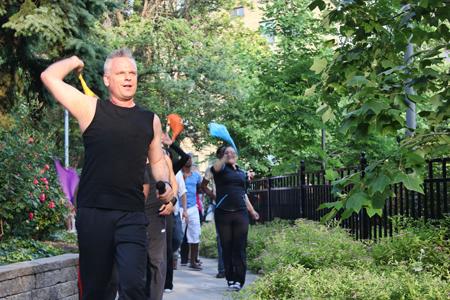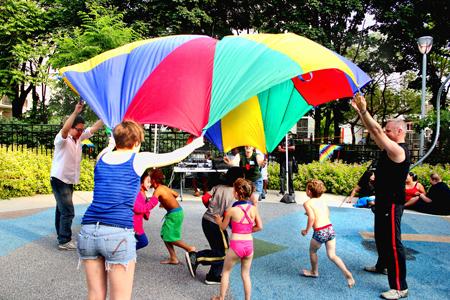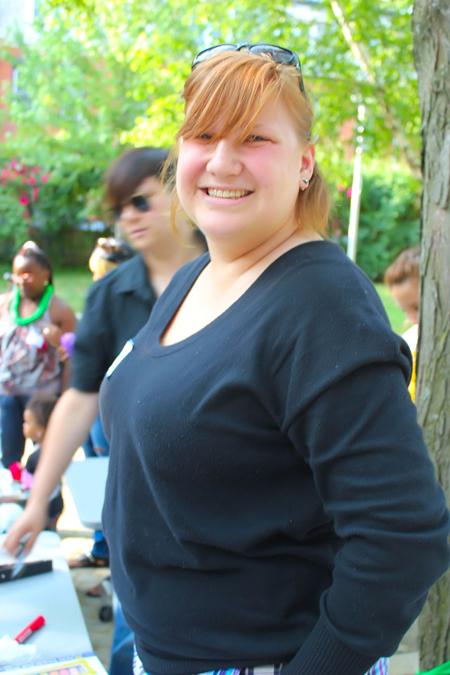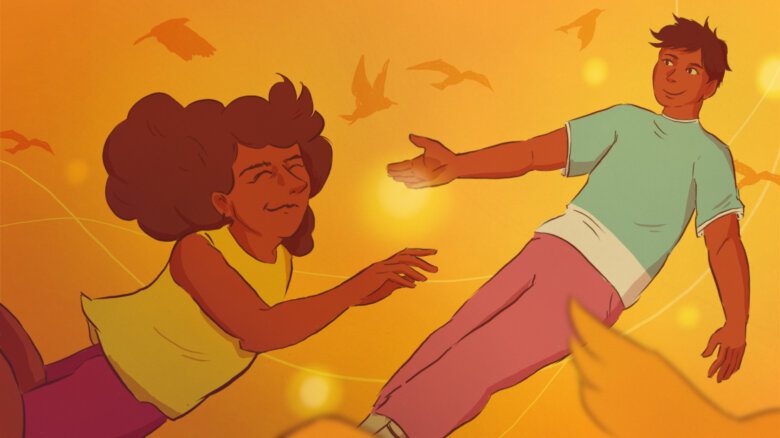
Chris Veldhoven leads a small parade of the members of the Queer Parenting Program at the 519 Church Street Community Centre. Credit: Krys Cee

Community members at The 519 want to give kids the tools to feel comfortable with their gender identity. Credit: Krys Cee
On June 21, the 519 Church Street Community Centre launched a survey for families of Ontario children whose behaviours diverge from current gender binaries. Organizers hope the survey will give administrators of community spaces like The 519 the information they need to offer families with gender-independent children more support.
Kyle Scanlon is the director of trans programming at The 519. He says the idea for the survey came as a response to calls to The 519 from families whose children’s genders diverged from the traditional binary; these families were struggling to help their children feel safe and respected.
“[Queer Parenting program director Chris Veldhoven and I] both agreed that it was important to find a way to help those parents,” Scanlon says.
But they didn’t feel they had enough information to offer programs that would fulfill parents’ needs. Thus, the Gender-Independent Children Survey was born. Amanda Johnston, who is a master’s of social work student and an intern at The 519, was asked to compile the research. She says she hopes the survey will “offer more information for these families” and give them the ability “to determine what feels right for them.”
For Johnston, the very process of creating the survey carried lessons about the way children are perceived.
She started by reading scientific and psychiatric journals, as well as parent blogs and other more personal narratives. She found that language used by doctors and third parties often clashed with the way families talked about their own children.
“Gender identity disorder” is the official description used for gender-variant identities in children, according to the third and fourth editions of the American Psychiatric Association’s Diagnostic and Statistical Manual of Mental Health, Johnston says. “That permeates through the language used by doctors. They view it as a disorder.”
On the other hand, Johnston says, parents “wanted to normalize their kids’ behaviour, rather than ‘make their kids normal.’”
“It feels important to reframe the way these kids are looked at,” she says. She would like to see gender-variant behaviours in children respected as part of a “journey” rather than as representative of an already-set identity.
Claire Hall is coordinator of children’s programming at The 519. She says she’s happy about the launch and is looking forward to the information she hopes the survey will provide. At the same time, she’s concerned that its existence may reflect an increasingly strict gender binary.
“My own children, I raised in the ’80s,” she remembers. “We fought very hard not to have girl toys and boy toys and girls’ play and boys’ play.”
“I see it as really going back to before that time, and I’m just wondering where that’s coming from and if people have more of a preconceived notion of how children should play related to their gender,” she says.
Hall worries that naming some children as gender independent could reinforce the idea that children should be fitting certain norms. “Isn’t everyone gender variant?” she asks. “What we should be doing is following the child’s lead.”
Scanlon says recent attitudes toward gender-variant children have been regressive. He points to the recent controversy over Storm, the child whose gender parents did not want to disclose and “the hate-filled responses in the media.”
“When a child diverts from the quote-unquote normal path, it’s really upsetting to a lot of people,” Scanlon says.
But he rejects the idea that this survey will somehow label gender-independent children as other or outside of the norm.
“The psychiatric establishment has put labels on children for a long time,” he points out. He adds that while some supposedly gender-bending behaviours, such as girls playing sports, may be acceptable, “a boy dressing up in girls’ clothes is seen as a travesty.”
Terrence Rodriguez is a trans man who, as a child, did not fit traditional gender norms. “Growing up I was the masculine one… I wanted to play with all the guys,” he remembers. He says that while he felt isolated from his peers as a child, his experiences were left unaddressed by teachers and other adults. Rodriguez wants to see more “education for anybody who will be working with kids.”
He would also like to see more information about gender-independent youth leading to “space where they’re supported in what they want to do” for children who feel different, as well as increasingly gender-neutral spaces for all children in their everyday lives.
The survey was six months in the making; work began on its creation in January. It asks caregivers questions like “Which words or terms, if any, are you most comfortable with in describing your child, and for what reasons?” and “What impact have other people’s reactions to your child/ren’s gender independence had on you as a primary caregiver?”
“We worked really hard on this to try to put together a survey that reflected and honoured families and their right to self-determination and that of their children,” Johnston says.


 Why you can trust Xtra
Why you can trust Xtra


